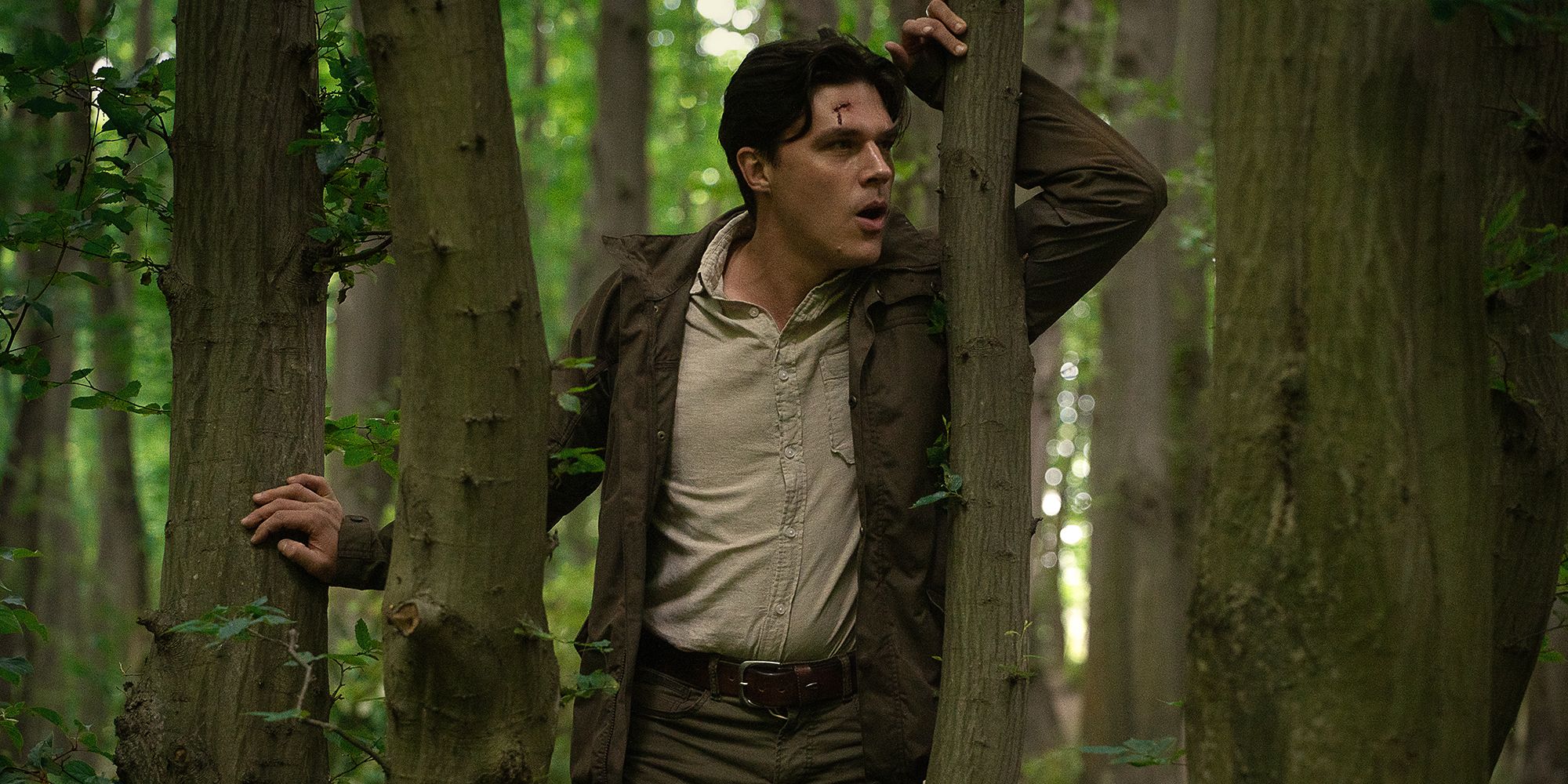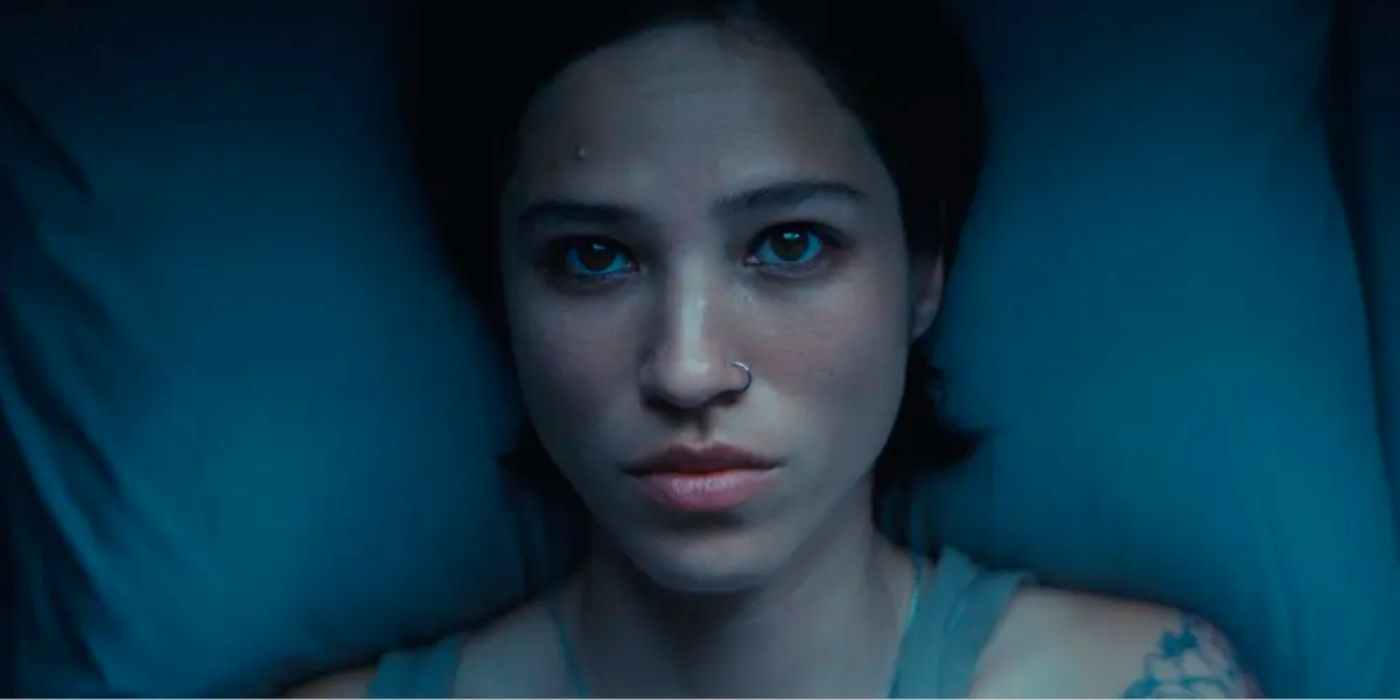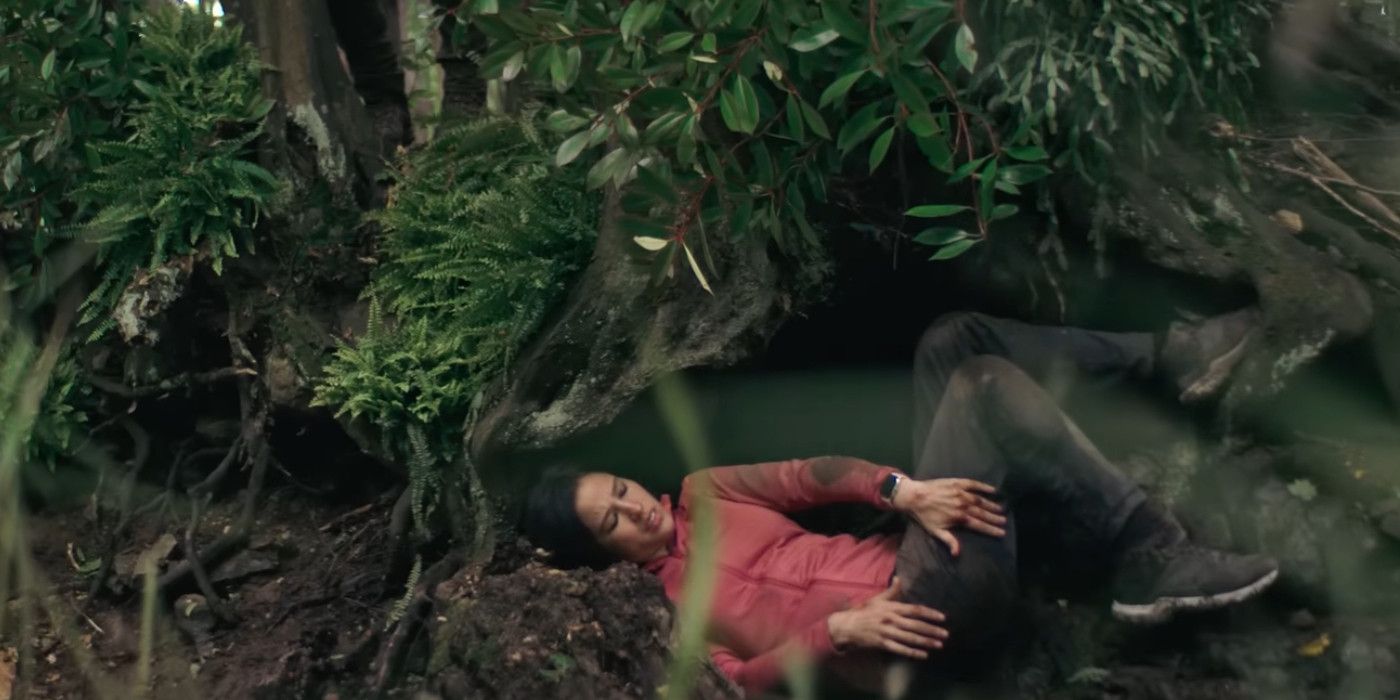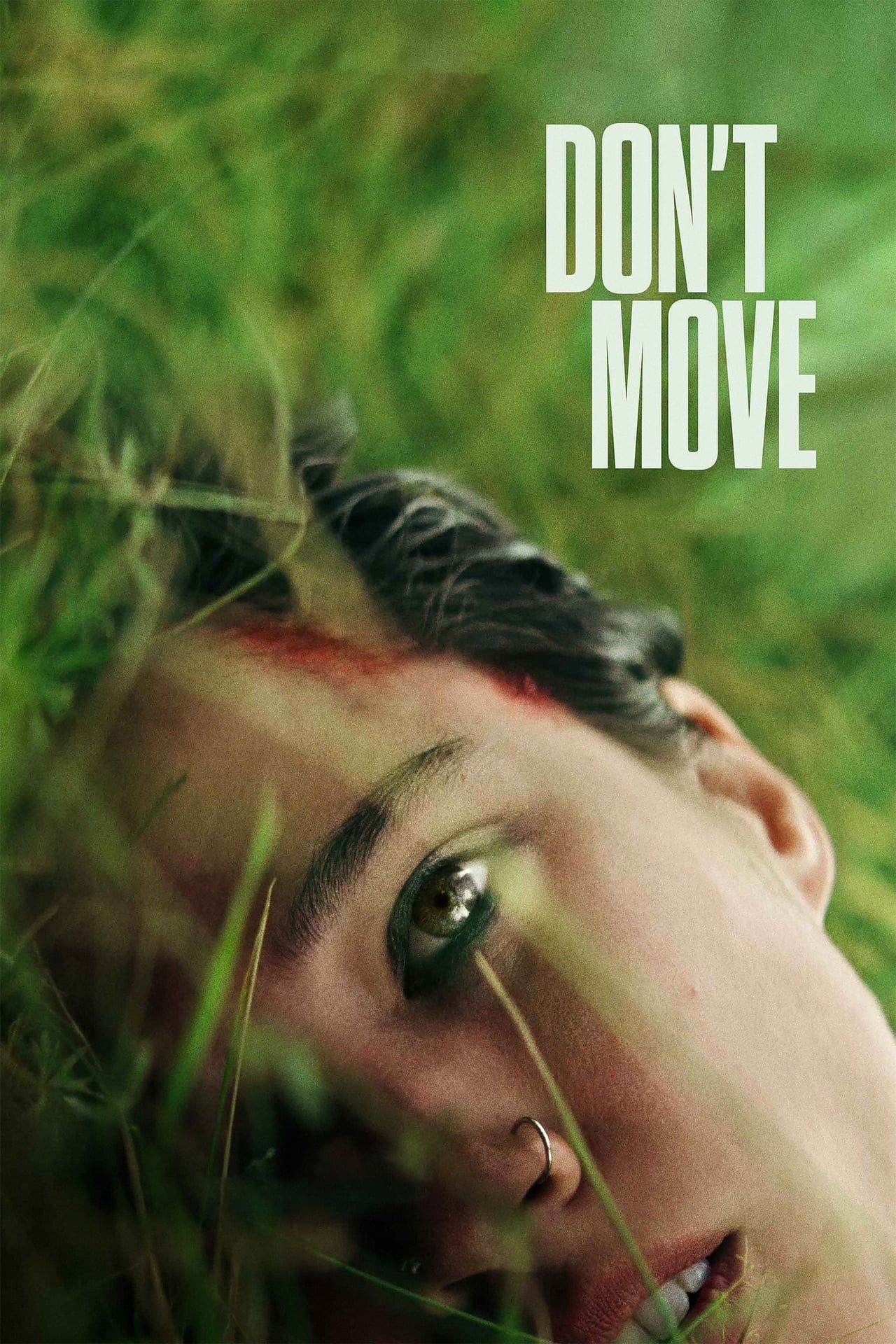The Sam Raimi-produced thriller Don’t Move has already climbed to the top spot on Netflix’s global streaming charts since its October 25 release, and it’s no surprise given the unique premise and stellar performances from its lead actors. The movie is directed by Adam Schindler and Brian Netto, who previously helmed an episode of Raimi’s 50 States of Fright anthology, from a screenplay by T.J. Cimfel and David White, who also penned their last thriller Intruders.
Don’t Move follows a woman named Iris, played by Yellowstone star Kelsey Asbille, who is dealing with grief from her son’s death when a chance encounter with a killer forces her to kick her survival instincts into high gear. Said killer is Richard, played by American Horror Story‘s Finn Wittrock, who injects Iris with a paralytic agent and expects her to die within 20 minutes. But much to his surprise, Iris fights back even as paralysis begins to take hold, and their cat-and-mouse game becomes increasingly creative as she must battle her own body to save herself.
Related
Don’t Move Review: Expansive Spaces Make Way For Claustrophobic Terror In Sam Raimi-Produced Horror
Don’t Move creates a beautiful parallel between the vast expanse of the outdoors and the claustrophobia of a woman trapped in her own body.
ScreenRant interviewed Netto and Schindler about how they plotted out the character arcs of Don’t Move from its early stages, the kismet casting of Kelsey Asbille and Finn Wittrock, and why even the score for the film had to be perfectly blended.
One Of The Biggest Constraints Of Don’t Move Was Also Its Biggest Strength In The Script Stage
“Everything’s a challenge, and we were just rolling with the punches as they came.”
Screen Rant: You both mentioned that you wanted this film to take place in real-time, which is genius. What were some of the challenges and rewards of using that format?
Adam Schindler: Continuity is a big one. This is not a spoiler, but the movie takes place during the day. At first, we thought, “Okay, this is great. No night shoots, none of that.” But then you’re dealing with sunlight coming through the trees and various different things. Most of the movie takes place outdoors, so you’re dealing with the potential of rain changing sunlight. So, I would say that continuity was the biggest challenge when it comes to shooting a real-time movie like that.
Brian Netto: Also, we love stories that feature characters who have some sort of an arc or trajectory from start to finish. The other challenge when you’re conceiving of something is figuring out a way in which your character can have a realistic journey and arc to them. But everything’s a challenge, and we were just rolling with the punches as they came.
Screen Rant: I find this story absolutely terrifying, and it’s something that actually could happen now. Can you elaborate on your collaboration process with T.J. Cimfel and David White, in regards to building the story and characters?
Brian Netto: Yeah, T.J. and David worked on our last film, Intruders. That was a spec, originally titled Shut In, that we had come upon and then made. For this one, we pitched them the concept and the constraint we gave them was to make sure that it takes place in real-time as much as possible. We said, “Good luck. Now let’s see what we’ve got.”
Adam Schindler: One of the other things we said was, “Let’s try not to go inside our head and hear any type of internal dialogue voiceover.” Make it a real step-by-step process, follow all the way through with what happens real-time, paint yourself into a corner, and then we’ll help you try to figure out a way out of it.
Brian Netto: Talking a little bit about the challenges of something that takes place in real-time and over the course of one day: This was it, right? And so we gave them things that we knew we wanted to lean into, and then also things we wanted to shy away from. But more than anything we knew that once we figured out what the journey she was going to be on was, we would then build an antagonist that would mirror that and be the consistent obstacle in her way to get to the end of her journey.
Once we settled on that, it happened incredibly quickly. The boys are brilliant at creating characters based on a really unique genre set up, so they took it and ran with it. What you saw was largely what happened after draft 2. Draft 2 is a lot of what you’re seeing in the film, which is pretty incredible.
Screen Rant: Were there any corners that had you like, “Alright, this is really hard. How do we figure our way out of this one?”
Adam Schindler: I would say there were a few iterations of some certain sequences where we were like, eh, I think we painted ourselves in too much into a corner and had to back out and go, okay, it has to be realistic. You have to be able to, what we don’t want to do is paint yourself into a corner and then have your characters doing and making choices and doing things that take you out of the movie and go, okay, this is supposed to feel realistic. You can’t be, so you have to take away any type of communication for her and things like that. It’s just trying to find realistic ways in which that can happen and then try to find your way out. TJ and Dave are great at crafting sequences like that, so we had a couple of ideas and then we let them go away and create a bunch of ’em on their own, and they did a fantastic job.
Don’t Move Is An Acting Tour De Force For Kelsey Asbille & Finn Wittrock
“She had to place her performance in our hands, and she gave us incredible stuff to work with.”
Screen Rant: Kelsey’s phenomenal in this film. How did you guide her journey through these complex emotions, given the limited physical movement?
Brian Netto: We have a good friend who’s married to an anesthesiologist, and one of the first things we did was set up a call where we went with her through the script. She was like, “Okay, you don’t mention what this is, but this is how it would work.” And then we brought Kelsey into the conversation to talk about what that would look like, what the mobility would look like, how it would start to break down, and what the muscles are feeling in that moment.
We had that conversation before we left, and then we journeyed halfway across the world and landed, where we had conversations with her about at what point in the script she’s able to do what. We just kind of broke it down that way, like, “Alright, at this moment, you’re able to do this. At that moment, you’re able to do that.”
But more than anything, a lot of it was the trust that she had to place in Adam and I to make sure that she wasn’t doing too much or too little. Because that’s always the conversation. “Am I giving you enough?” And we were telling her more often than now, “What you’re expressing through your eyes is great, because that’s all you have at this particular moment. It’s coming through”. It’s all the things that she needed to do. She was able to convey through her eyes when she was in that most vulnerable state, and it was great to watch her work. But it’s really about trust; she had to place her performance in our hands, and she gave us incredible stuff to work with.
Adam Schindler: We were just making sure we were prepared, just knowing exactly what her body is doing at what times. Having that all planned out ahead of time, so that when she’s in a sequence and we’re shooting in the middle of the forest or what have you, there’s not a question of, “Where am I with my abilities?” and all this kind of stuff. We had that stuff all planned out, so she could just go and be the character, and not have to worry about that stuff. And she did a phenomenal job.
Screen Rant: She absolutely did, and so did Finn. He is so unnerving at times, and he’s such a great liar in the moment. What did Finn bring to his role that went beyond the page?
Brian Netto: Yeah, it’s a tough role because we wanted someone that was charming. We wanted someone that could exude a menace we needed when we needed it, but at the same time be someone that you understood and connected with. Even though we’re only meeting these characters for 90 minutes, you have to understand the way he’s been able to work prior to this film beginning and the success he’s had. He’s been able to do this over and over and over again because he is so good at taking the mask off. He’s just constantly wearing masks, and he can do it in any situation at the drop of a hat to get whatever he needs in that one particular moment.
Adam Schindler: It was really important for us to make sure that the audience wasn’t creeped out by him too early on. It had to feel like he was a real person – not that you really know who he is by the end, or which personality is him. Maybe you don’t end up seeing which is his real personality in the movie. But we spent a lot of time talking to Finn about the masks that he wears, and we were laughing on set because it’s kind of like a messed up therapy session between the two of them.
In one part, he’s a psychiatrist, and in another part, she’s a psychiatrist. They’re kind of needling each other and just finding those moments where she can poke at his humanity, and you kind of see a little bit of his humanity come through before he is able to kind of stifle it a little bit. It was important that we found somebody who was able to do that dance. Finn is fantastic at being charming but menacing at the drop of a hat within the scene; within moments, he’s just able to do that. It was fun to watch.
Screen Rant: Kelsey described the film as both propulsive and personal. How do you balance the high-stakes thriller element with the more intimate personal moments in this film?
Brian Netto: I think that starts with the script, right? Because we were so involved in the development of it, we made sure that along the way you understood where she was in her journey. Obviously, she’s trying to survive this ordeal, but then there’s something larger at stake here that puts her in this position we find her when the film begins. We have to understand where she is along the way, through the conversations she’s having with this Richard or Andrew or whoever he is.
And so every time we had an opportunity to do so, we wanted to see some of that come through, whether that’s the guilt that’s coming through or the fire that is being stoked inside of her through their interactions. It was always a conversation of where she is in her journey. We’d had those conversations with Kelsey when we first met with her, trying to figure out when the moment in which it comes on for her again happens, where she’s like, “I’m ready to continue to fight.”
Adam Schindler: We developed this story with T.J. and David over the later parts of the pandemic when everybody was still home doing this Zoom thing and developing it that way. So, there was a universal aspect of feeling trapped in your own house or your own body, and this idea of, “When are we ever going to be able to get out and go on with our lives?” All of that was in the ether when we were developing it, so I think it seeped into the script in certain ways. I feel like it really helped convey the thoughts and ideas that we have going on in the thing and really made it present for all.
Brian Netto: Obviously, her trauma is very specific, but it was so easy to visualize it being something that anyone can relate to. We’ve all gone through situations where we’re down, and we have to push ourselves back up. So, we felt that was very universal and would speak to any culture, to any language, to any belief system that you adhere to. We knew that that would speak to people, and if that is working as well in addition to the top layer of the thrills, then we knew we’d have something that could potentially have an effect on people outside of the pure fun of just watching her go through this ordeal.
Screen Rant: Adam, I read an article where you mentioned that Kelsey and Finn were very giving on set. Can you share a specific moment where their collaborative spirit significantly impacted a scene?
Adam Schindler: Yeah, there’s a scene that takes place in a pickup truck that’s pulled over on the side of the road. It’s an intense scene, and there’s some monologuing that goes on, so your camera’s tight on one person. A lot of times you could expect the other actor to be like, “There’s no room for me to sit next to the camera, so I’m going to go away.” But they were both like, “No, I’m going to be here right beside the camera to give what the other person needs.”
It’s very similar to a story I heard about Tom Hanks a long time about on The Green Mile, where he was sitting there off-camera. You think Tom Hanks is going to say, “I’m going to go back to my trailer,” but he was sitting there for every moment next to the camera, giving it his all. He’s giving an Oscar performance outside the camera. It was very much like that.
Brian Netto: Yeah, a lot of times people will just give you the lines, but it’s one thing to give lines versus to give you the same performance that you’re going to need to elicit the emotion you need to reach. They were fantastic with respect to that. They got along great, which was obviously a help to the production and to us. They brought the best out of each other without a doubt.
Don’t Move Is A Masterclass In Building Tension – With Adam Schindler & Brian Netto As Its Teachers
“How do we really sit in this moment, make it uncomfortable, and let the camera linger?”
Screen Rant: I felt as if I was on the edge of my seat for the whole hour and a half of this film. Can you talk about what techniques you used to amp up the tension?
Adam Schindler: A lot of it is not being scared to sit in shots for a little bit longer than people are used to at this point. You know what I mean? These types of movies, real-time thrillers, have cameras flying all around a lot of times. There’s just a lot of fast-paced editing and what have you. We really charged ourselves with sitting there and going, “How do we really sit in this moment, make it uncomfortable, and let the camera linger?” We let people experience the frame, and let them experience the moment with her. I think that was the key.
Brian Netto: We wanted to put the viewer in Kelsey’s shoes, and we wanted them to experience what she’s experiencing without going inside her head or living in her POV, per se. And a lot of the ways we figured we could do that was just being with her. If you’ll notice, for a lot of this film, she’s always in frame. You’re sensing her, you’re feeling her, and we worked with the sound design team to create the sensation of what it’s like to have this narcotic coursing through her system.
She’s in this incredibly beautiful environment, but now she’s got something else that’s augmenting the environment and making it sound a little bit different. And then our composing team is incredible, Mark Korven and Michelle Osis. If you’ve heard Mark’s stuff on The Witch or
The First Omen
, you know he’s so talented. Mark and Michelle created a sound design and score that blended together so that you couldn’t tell which one you were hearing. You’re hearing these sounds that make your skin crawl, and a lot of it was dictated by the idea that if you’re feeling what she’s feeling, you’re as anxious and as tense as she is.But also, a lot of that work has to be done early on with the character work. Because if you don’t care that your protagonist is going through this, if your protagonist isn’t scared, and if you’re not scared for her, you’re not on the edge of your seat. There isn’t an investment that you have as an audience member. So, you have to care about them, and you have to be able to put yourself in their shoes. You have to win when they win and lose when they lose – and she does a lot of losing, so you have to be there with her when that’s happening.
Adam Schindler: Yeah, we had tons of conversations in prep with our DPs, and we spent a lot of time talking about how this movie can be from her perspective, but not necessarily always from POV. That was a big part of it, making sure that she’s in the frame or that it’s coming from her direction or her perspective all the time. It’s her movie, it’s her journey – and having that all planned out ahead of time meant that when you’re up against it on the day, you’re not willing to break that.
When you get halfway through the production, you’re sometimes just like, “We’ve got to make our day,” and you start rethinking everything. But we could stick with the plan. “This is what you have, and this is the perspective, and this is how we’re going to do this.” I was glad our DP was always reminding us that this is our plan. It was pretty awesome.
Screen Rant: What did you both learn from the directing actors in such physically and emotionally constrained roles, and how might these lessons influence your future projects?
Adam Schindler: Great question. I think we just learned that it’s all in casting. For character work, it all starts in the casting. Get the right actors who understand the story the way you do, that are on the same page from day one, and then let them explore and find the characters. They’re the actors; they’re the talent on screen.
Ultimately, it was our brainchild, and TJ and David wrote it, but they’re embodying the character. You give the character over to them, and you have to trust that they know what that character wants and needs for their scenes. Our job as the director is just to keep it within the lane of the movie as a whole, but to let them really be the characters and trust their judgment.
Brian Netto: And then prioritize. This is the most amount of time we’ve had to rehearse on a film – and it wasn’t by any means a lot of time, but it was more than we’d had prior to that. And so a lot of it happened in these conversations about, “Am I kneeling here? Why am I kneeling? Maybe I’m standing. Maybe it makes more sense if I’m approaching it this way.” Those are incredible conversations.
It’s one thing to have the blueprint, which is the script, and it’s another thing to create a shot list that looks great. But the most important thing is to make sure that they’re behaving in the way that they would behave as real people, but also as their characters. It’s really just a collaboration, and you need to be giving it time. I think what we’ll do moving forward is always make sure that we hand over the role to them and let them be the character. The other thing is to give ourselves the time to explore and have those conversations before we get in there and actually begin filming, so that we can figure out the best way forward.
Adam Schindler: We work out all the kinks, so there are no questions on the day. There are no questions at all. You’re all there doing the same thing. You’re all paddling in the same direction.
More About Don’t Move (2024)
When a killer injects her with a paralytic agent, a woman must run, fight, and hide before her body completely shuts down.
Check out our other Don’t Move interviews here:
Don’t Move
begins streaming October 25 on Netflix.









